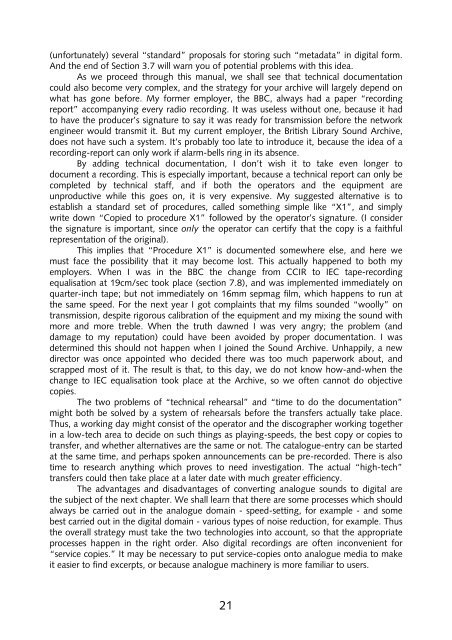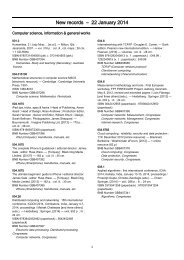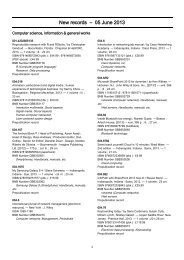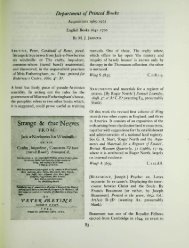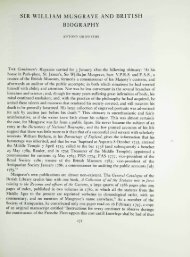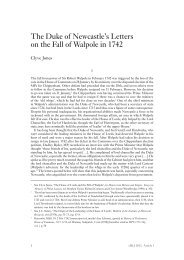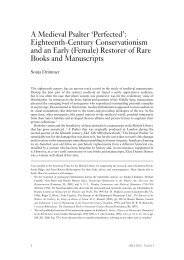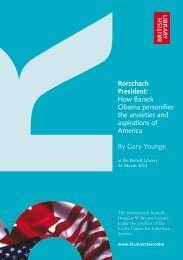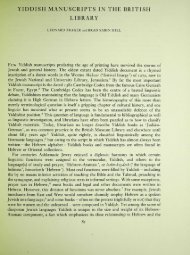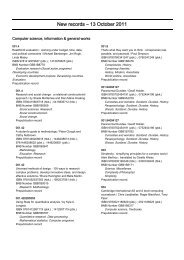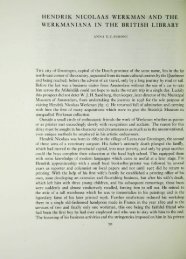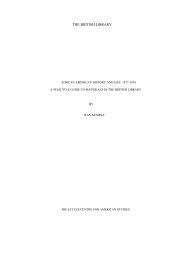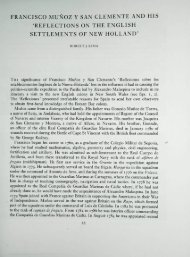MANUAL OF ANALOGUE SOUND RESTORATION ... - British Library
MANUAL OF ANALOGUE SOUND RESTORATION ... - British Library
MANUAL OF ANALOGUE SOUND RESTORATION ... - British Library
Create successful ePaper yourself
Turn your PDF publications into a flip-book with our unique Google optimized e-Paper software.
(unfortunately) several “standard” proposals for storing such “metadata” in digital form.<br />
And the end of Section 3.7 will warn you of potential problems with this idea.<br />
As we proceed through this manual, we shall see that technical documentation<br />
could also become very complex, and the strategy for your archive will largely depend on<br />
what has gone before. My former employer, the BBC, always had a paper “recording<br />
report” accompanying every radio recording. It was useless without one, because it had<br />
to have the producer’s signature to say it was ready for transmission before the network<br />
engineer would transmit it. But my current employer, the <strong>British</strong> <strong>Library</strong> Sound Archive,<br />
does not have such a system. It’s probably too late to introduce it, because the idea of a<br />
recording-report can only work if alarm-bells ring in its absence.<br />
By adding technical documentation, I don’t wish it to take even longer to<br />
document a recording. This is especially important, because a technical report can only be<br />
completed by technical staff, and if both the operators and the equipment are<br />
unproductive while this goes on, it is very expensive. My suggested alternative is to<br />
establish a standard set of procedures, called something simple like “X1”, and simply<br />
write down “Copied to procedure X1” followed by the operator’s signature. (I consider<br />
the signature is important, since only the operator can certify that the copy is a faithful<br />
representation of the original).<br />
This implies that “Procedure X1” is documented somewhere else, and here we<br />
must face the possibility that it may become lost. This actually happened to both my<br />
employers. When I was in the BBC the change from CCIR to IEC tape-recording<br />
equalisation at 19cm/sec took place (section 7.8), and was implemented immediately on<br />
quarter-inch tape; but not immediately on 16mm sepmag film, which happens to run at<br />
the same speed. For the next year I got complaints that my films sounded “woolly” on<br />
transmission, despite rigorous calibration of the equipment and my mixing the sound with<br />
more and more treble. When the truth dawned I was very angry; the problem (and<br />
damage to my reputation) could have been avoided by proper documentation. I was<br />
determined this should not happen when I joined the Sound Archive. Unhappily, a new<br />
director was once appointed who decided there was too much paperwork about, and<br />
scrapped most of it. The result is that, to this day, we do not know how-and-when the<br />
change to IEC equalisation took place at the Archive, so we often cannot do objective<br />
copies.<br />
The two problems of “technical rehearsal” and “time to do the documentation”<br />
might both be solved by a system of rehearsals before the transfers actually take place.<br />
Thus, a working day might consist of the operator and the discographer working together<br />
in a low-tech area to decide on such things as playing-speeds, the best copy or copies to<br />
transfer, and whether alternatives are the same or not. The catalogue-entry can be started<br />
at the same time, and perhaps spoken announcements can be pre-recorded. There is also<br />
time to research anything which proves to need investigation. The actual “high-tech”<br />
transfers could then take place at a later date with much greater efficiency.<br />
The advantages and disadvantages of converting analogue sounds to digital are<br />
the subject of the next chapter. We shall learn that there are some processes which should<br />
always be carried out in the analogue domain - speed-setting, for example - and some<br />
best carried out in the digital domain - various types of noise reduction, for example. Thus<br />
the overall strategy must take the two technologies into account, so that the appropriate<br />
processes happen in the right order. Also digital recordings are often inconvenient for<br />
“service copies.” It may be necessary to put service-copies onto analogue media to make<br />
it easier to find excerpts, or because analogue machinery is more familiar to users.<br />
21


